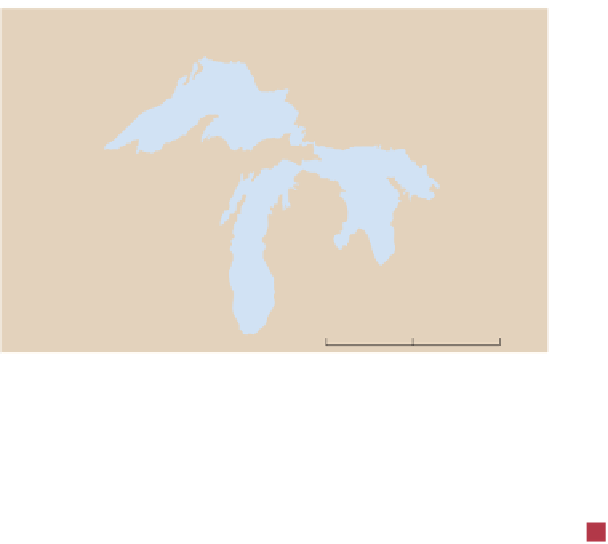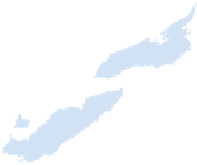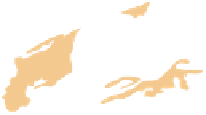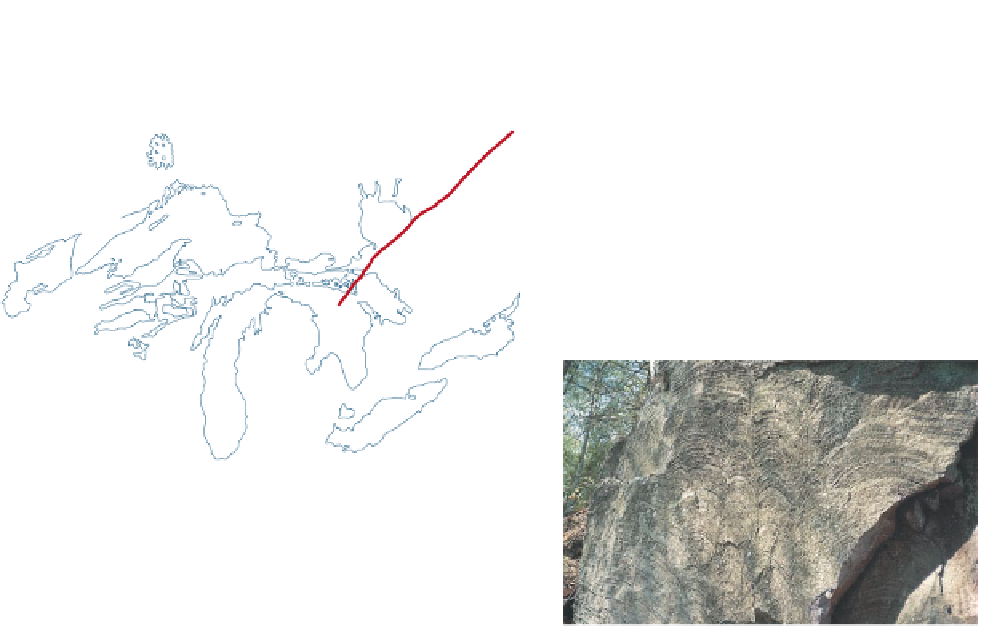Geology Reference
In-Depth Information
◗
Figure 19.11
Paleoproterozoic Sedimentary Rocks
Canada
b
Outcrops in the region of the Mesnard Quartzite. The
crests of the ripple marks point toward the observer.
Mainly sedimentary
Mainly volcanic
0
250
500 km
a
Distribution of Paleoproterozoic-age rocks in the Great Lakes region.
c
The Kona Dolomite outcrops. The bulbous structures
are stromatolites that resulted from the activities of
cyanobacteria (blue-green algae).
Meso- and Neoproterozoic-age sedimentary rocks are
exceptionally well exposed in the northern Rocky Mountains
of Montana, Idaho, and Alberta, Canada (
and recently one dated at 3.8 billion years old (Eoarchean) was
discovered in Greenland. Furthermore, these ancient ophiolites
compare closely with well-documented younger ones such as
the Jormua mafi c-ultramafi c complex in Finland.
Supercontinents may have existed as early as the Late
Archean, but if so, we have little evidence of them. The fi rst
supercontinent that geologists recognize with some certainty,
known as
Rodinia
(
Figure 19.13a).
Like the rocks in the Great Lakes region, they are mostly
sandstones, shales, and stromatolite-bearing carbonates.
Sedimentary rocks of Proterozoic age are also found in
Utah and the Grand Canyon in Arizona (Figure 19.13b). The
rocks, consisting mostly of sandstone, shale, and dolostone,
were deposited in shallow-water marine and fluvial envi-
ronments. The presence of stromatolites and carbonaceous
impressions of algae in some of the rocks indicate probable
marine deposition.
◗
Figure 19.14), assembled between
1.3 and 1.0 billion years ago and then began fragmenting
750 million years ago. Judging by the large-scale deforma-
tion, the
Pan-African orogeny,
that took place in what are now
the Southern Hemisphere continents, geologists conclude
that Rodinia's separate pieces reassembled about 650 mil-
lion years ago and formed another supercontinent, this one
known as
Pannotia
. And finally, by the latest Proterozoic,
about 550 million years ago, fragmentation was underway
again, giving rise to the continental confi guration that ex-
isted at the onset of the Phanerozoic Eon (see Chapter 20).
◗
A
continent
is one of Earth's landmasses consisting of granitic
crust with most of its surface above sea level. A
supercontinent,
in contrast, consists of all or at least much of the continents, so,
other than size, it is the same as a continent. The supercontinent
Pangaea that existed at the end of the Paleozoic Era is familiar,
but few are aware of earlier supercontinents.
Before specifically addressing supercontinents, though,
we must note that the present style of plate tectonics involving
opening and then closing ocean basins had almost certainly been
established by the Paleoproterozoic. In fact,
ophiolites
(rocks of
the upper mantle and oceanic crust) that provide evidence for
convergent plate boundaries are known from Neoarchean and
Paleoproterozoic rocks from Russia and China, respectively,
The same crust-forming processes that generated Archean
granite-gneiss complexes and greenstone belts continued
during the Proterozoic, but they did so at a considerably
reduced rate. Additionally, many Archean rocks have been
thoroughly metamorphosed, whereas vast exposures of
Proterozoic rocks show little or no effects of metamorphism
(Figures 19.11 and 19.13).



































Search WWH ::

Custom Search